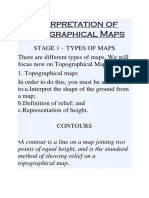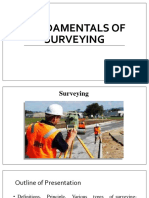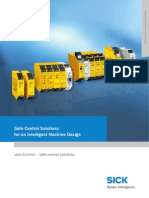0 ratings0% found this document useful (0 votes)
2 viewsNotes Topograph
Notes Topograph
Uploaded by
jsinchukeCopyright:
© All Rights Reserved
Available Formats
Download as DOCX, PDF, TXT or read online from Scribd
Notes Topograph
Notes Topograph
Uploaded by
jsinchuke0 ratings0% found this document useful (0 votes)
2 views2 pagesCopyright
© © All Rights Reserved
Available Formats
DOCX, PDF, TXT or read online from Scribd
Share this document
Did you find this document useful?
Is this content inappropriate?
Copyright:
© All Rights Reserved
Available Formats
Download as DOCX, PDF, TXT or read online from Scribd
Download as docx, pdf, or txt
0 ratings0% found this document useful (0 votes)
2 views2 pagesNotes Topograph
Notes Topograph
Uploaded by
jsinchukeCopyright:
© All Rights Reserved
Available Formats
Download as DOCX, PDF, TXT or read online from Scribd
Download as docx, pdf, or txt
You are on page 1of 2
Notes: Topographic Maps and Orienteering
1. What is a topographic map, and what do you find on it?
• A map showing detailed features of the Earth’s surface, including natural and man-
made features.
• Features include: Elevation (contour lines), bodies of water, forests, roads, buildings,
and landmarks.
• Uses:
1. Navigation for hiking, camping, or orienteering.
2. Planning construction or land development.
3. Military operations and emergency services.
2. 20 signs and symbols on topographic maps:
• Contour lines
• Water bodies (lakes, rivers)
• Forests
• Buildings
• Roads (highways, trails)
• Railroads
• Bridges
• Elevation markers
• Fences
• Quarries
• Marsh/swamp areas
• Boundaries (state, park, etc.)
• Power lines
• Mines
• Campsites
• Cliffs
• Dams
• Wells
• Schools
• Churches
3. Nomenclature of an orienteering compass:
• Baseplate
• Magnetic needle
• Compass housing with degree markings
• Direction of travel arrow
• Index line
• Rotating bezel
• Orienting lines
• Orienting arrow
4. Terms and Definitions:
• Elevation: Height above sea level.
• Contour interval: Vertical distance between contour lines.
• Magnetic North: Direction indicated by a compass needle.
• Declination: Difference between Magnetic North and True North.
• Scale: Ratio of map distance to actual ground distance.
• Measuring: Determining distance or angle on a map.
• Back-azimuth: Reverse direction of an azimuth, calculated by adding/subtracting 180°.
• True North: Geographic North Pole direction.
• Azimuth: Compass direction from one point to another, measured in degrees.
• Distance: Linear measurement between two points.
• Ground forms: Physical features of the Earth’s surface (hills, valleys, etc.).
5. Shooting a magnetic azimuth:
• Hold the compass flat and level.
• Align the direction of travel arrow with your target.
• Rotate the compass housing until the magnetic needle aligns with the orienting arrow.
• Read the degree marking at the index line.
6. Marching on a magnetic azimuth:
• Align the compass with your azimuth bearing.
• Choose a visible landmark on your path.
• Walk towards the landmark, rechecking the compass periodically.
7. Two methods to correct for declination:
• Adjustable compass: Set the declination adjustment directly on the compass.
• Manual correction: Add or subtract declination from your compass reading.
• When necessary: Correct declination when the difference between Magnetic and True
North affects accuracy (e.g., in regions with significant declination).
8. Orienting yourself and a map:
• By inspection: Match landmarks on the map to visible surroundings.
• By compass: Align the map’s North with Magnetic North on the compass.
9. Resection and its use:
• Definition: Determining your position by using two or more known landmarks.
• Use: Draw lines from landmarks’ bearings on the map; the intersection is your location.
10. Proving map/compass skills:
• Successfully navigate a 1-mile (1.6 km) course with five control points using bearings
and map landmarks.
You might also like
- Earth: Our Home: Geography ElectiveDocument25 pagesEarth: Our Home: Geography ElectiveVernon100% (1)
- Celest Navig 02Document37 pagesCelest Navig 02Eugenes GumeraNo ratings yet
- Terrestrial Navigation Data Bank OOWDocument32 pagesTerrestrial Navigation Data Bank OOWRaghad HadadNo ratings yet
- Topograph MapDocument21 pagesTopograph MapPrakash Kumar KumarNo ratings yet
- Online Education Outdoor NavigationDocument32 pagesOnline Education Outdoor NavigationR. Mega MahmudiaNo ratings yet
- Maps and DirectionsDocument3 pagesMaps and DirectionsaaravrakyanNo ratings yet
- Presenting by Soundararajan.K. A M.Tech R.S & GISDocument25 pagesPresenting by Soundararajan.K. A M.Tech R.S & GISSoundararajan ArumugamNo ratings yet
- Unit 9 Geography, Map Skills & OrienteeringDocument182 pagesUnit 9 Geography, Map Skills & OrienteeringRavi BhollahNo ratings yet
- Topographic Maps LectureDocument19 pagesTopographic Maps Lecturekali_abel100% (1)
- Topographic Landsat Maps LectureDocument19 pagesTopographic Landsat Maps LectureErland PrasetyaNo ratings yet
- OrienteeringDocument35 pagesOrienteeringLija Sue Regalado50% (2)
- Lecture 3 CartographyDocument32 pagesLecture 3 CartographymokolobetsiNo ratings yet
- 2 The EarthDocument35 pages2 The EarthDaniel EnglandNo ratings yet
- Land Surveying-1Document24 pagesLand Surveying-1siddharthjain9149No ratings yet
- Land SurveyingDocument24 pagesLand Surveyingsiddharthjain9149No ratings yet
- Geodesy and CartographyDocument65 pagesGeodesy and CartographyGiniux PreezNo ratings yet
- Module 1-Engineering SurveyDocument116 pagesModule 1-Engineering SurveySurekha Abhishek RaoNo ratings yet
- Interpretation of Topographical Maps PDFDocument33 pagesInterpretation of Topographical Maps PDFStudy in an easy way100% (1)
- Lecture+ 6 Distance MeasurementsDocument18 pagesLecture+ 6 Distance MeasurementsPrince RealerNo ratings yet
- Unit1 SurDocument23 pagesUnit1 Surhsbasavaraja03No ratings yet
- Compass Survey Report-TwetuDocument22 pagesCompass Survey Report-Twetutuk2ayodejiNo ratings yet
- Coordinate SystemDocument42 pagesCoordinate SystemAsaad AshooNo ratings yet
- Unit I Surveying and GeomaticsDocument124 pagesUnit I Surveying and GeomaticsshivarajNo ratings yet
- Chapter - 1 Map ReadingDocument21 pagesChapter - 1 Map ReadinggopeNo ratings yet
- Orienteering HonorDocument17 pagesOrienteering HonorNatalieMaldonadoNo ratings yet
- Class NCCDocument42 pagesClass NCCDeekshu 4141likilNo ratings yet
- LM ABE 12 Lesson 24Document20 pagesLM ABE 12 Lesson 24Eula YaoNo ratings yet
- MODULE 1 CE 214 Fundamentals of SurveyingDocument7 pagesMODULE 1 CE 214 Fundamentals of SurveyingJake Ryan Belen BuanNo ratings yet
- Fundamentals of Surveying - IntroductionDocument69 pagesFundamentals of Surveying - IntroductionJamaica Tayamora100% (1)
- Lecture - 3 - Key Concepts of GeographyDocument43 pagesLecture - 3 - Key Concepts of GeographyshifatNo ratings yet
- Survey Course - APS FormatDocument83 pagesSurvey Course - APS FormatHaffi Díaz López100% (1)
- Survey Lecture No. 01Document45 pagesSurvey Lecture No. 01Waseem AbbasNo ratings yet
- Data BankDocument42 pagesData Banksultan.xpxNo ratings yet
- Grade 8 Geography - Maps & AtlasesDocument7 pagesGrade 8 Geography - Maps & AtlasesKerrin DavidsNo ratings yet
- Surveying: Department of Civil Engineering NIT RourkelaDocument92 pagesSurveying: Department of Civil Engineering NIT Rourkelarodej54503No ratings yet
- Developable Non-DevelopableDocument16 pagesDevelopable Non-DevelopableakshayburdakNo ratings yet
- Science 7 PPT Week OneDocument29 pagesScience 7 PPT Week Onekyle brian talingtingNo ratings yet
- Social Studies Notes 1-3Document84 pagesSocial Studies Notes 1-3emilyetlhabanyeNo ratings yet
- 04 - Map ProjectionsDocument17 pages04 - Map ProjectionsMelisa AyuningtyasNo ratings yet
- Map Reading & NavigationDocument19 pagesMap Reading & NavigationNathan MarshNo ratings yet
- Surveying PowerpointDocument40 pagesSurveying PowerpointEarl Angelo AcuñaNo ratings yet
- CE-101 Elementary Surveying: ContouringDocument40 pagesCE-101 Elementary Surveying: ContouringMistr MaskNo ratings yet
- GE186-Lecture 3-CONTOURINGDocument70 pagesGE186-Lecture 3-CONTOURINGEdward Gabada JnrNo ratings yet
- Unit 1 CE 6304Document40 pagesUnit 1 CE 6304Pavan Kumar ArigiNo ratings yet
- Concept of Field Geology: Bala Ram UpadhyayaDocument13 pagesConcept of Field Geology: Bala Ram UpadhyayaLeninNo ratings yet
- GGH1501 Learning Unit 2Document51 pagesGGH1501 Learning Unit 2SiyathokozaNo ratings yet
- SurveyingDocument34 pagesSurveyingSuraj DhondNo ratings yet
- Fundamentals of SurveyingDocument28 pagesFundamentals of SurveyingPHEBY MOOGNo ratings yet
- AfricaDocument3 pagesAfricaapi-419817757No ratings yet
- Chapter 3 - Interpretation of Topographical MapsDocument6 pagesChapter 3 - Interpretation of Topographical MapsSurajit DasNo ratings yet
- محاضره نهائيه 1 23 -2022Document11 pagesمحاضره نهائيه 1 23 -2022khatabkha278No ratings yet
- ProjectionDocument27 pagesProjectionPrabin BhattaNo ratings yet
- Earths DimensionsDocument34 pagesEarths DimensionsMarvin AlegadoNo ratings yet
- Surveying: Important QuestionsDocument16 pagesSurveying: Important QuestionsDhanyaUnni100% (1)
- Surv1 Elementary Surveying - 5Document30 pagesSurv1 Elementary Surveying - 5RarImABigBear023No ratings yet
- Chapter1 CE20203Document27 pagesChapter1 CE20203ashishranjan1203No ratings yet
- CH 3 PowerPointDocument32 pagesCH 3 PowerPointnboykovNo ratings yet
- Chainsurveying 240228110534 16265abbDocument88 pagesChainsurveying 240228110534 16265abbAshish KumarNo ratings yet
- Compass Surveying FinalDocument51 pagesCompass Surveying FinalUmar KhanNo ratings yet
- Refrigeration Screw Compressors and Chilling Units PDFDocument8 pagesRefrigeration Screw Compressors and Chilling Units PDFAmandeep singhNo ratings yet
- BASF MasterEmaco S488Document2 pagesBASF MasterEmaco S488HJNo ratings yet
- GC Electronics Co 1962Document5 pagesGC Electronics Co 1962Munberu AleashNo ratings yet
- Structures - Iii: Earthquake Behavior of BuildingsDocument24 pagesStructures - Iii: Earthquake Behavior of Buildingsabhivyakti kushwahaNo ratings yet
- Refrigerador LG GR43W11CVFDocument11 pagesRefrigerador LG GR43W11CVFOrlando YaguasNo ratings yet
- RCCP Conc - BreakupDocument1 pageRCCP Conc - BreakupPrabhakar LadNo ratings yet
- Transkrip Mini Eng 2Document2 pagesTranskrip Mini Eng 2Mazhar Ab LajisNo ratings yet
- Mahesh Kumar - Vallakati, B.Tech Mechanical Engineering: (CAD Design Engineer)Document1 pageMahesh Kumar - Vallakati, B.Tech Mechanical Engineering: (CAD Design Engineer)Vallakati Mahesh kumarNo ratings yet
- The Role of Team Effectiveness in Construction Project Teams andDocument24 pagesThe Role of Team Effectiveness in Construction Project Teams andTilahun NigussieNo ratings yet
- 2 - UK National Annex To Eurocode 5 - Design of Timber Structures. BridgesDocument10 pages2 - UK National Annex To Eurocode 5 - Design of Timber Structures. BridgesGillan Siang Kwang LioNo ratings yet
- Pages From Diffusers - 2022 - V1Document13 pagesPages From Diffusers - 2022 - V1Ahmed NabilNo ratings yet
- Literature ReviewDocument19 pagesLiterature ReviewKaung KhantNo ratings yet
- Ah 00212Document17 pagesAh 00212maithuong8567% (6)
- Product CatalogueDocument7 pagesProduct CatalogueKalidass BackNo ratings yet
- A320 QBDocument88 pagesA320 QBraiday8469% (16)
- Section 5: 5.1 Spare PartsDocument56 pagesSection 5: 5.1 Spare PartsJázio OliveiraNo ratings yet
- C GVSP 04Document2 pagesC GVSP 04rab_forceNo ratings yet
- RD-240TV - Aa1 - 013289 2014Document135 pagesRD-240TV - Aa1 - 013289 2014Artur RutraNo ratings yet
- RC - CES-605 Installation Manual - 523-0808269 - Edn 4-Rev 1Document446 pagesRC - CES-605 Installation Manual - 523-0808269 - Edn 4-Rev 1hukumranbilisimNo ratings yet
- It's Electric v.2Document2 pagesIt's Electric v.2Secure Energy FutureNo ratings yet
- DB-PRD-F-01-00 - Route Card - Weapon Control Panel IntegrationDocument1 pageDB-PRD-F-01-00 - Route Card - Weapon Control Panel IntegrationaartiNo ratings yet
- Safe Control Solutions For An Intelligent Machine DesignDocument26 pagesSafe Control Solutions For An Intelligent Machine Designณฏฐดลป์เสรีชนคนไทยพวนNo ratings yet
- Impact of Single and Dual Pressure Butt-Welding Procedures On The Reliability of PE 100 Pipe WeldsDocument7 pagesImpact of Single and Dual Pressure Butt-Welding Procedures On The Reliability of PE 100 Pipe WeldsThouraya HbsNo ratings yet
- Tank Standards and Part 4 SP001 InspectionsDocument24 pagesTank Standards and Part 4 SP001 Inspectionsrobertantoreni100% (1)
- CE3491 & Strength of Materials QBDocument3 pagesCE3491 & Strength of Materials QBmech.shanmugaselvamNo ratings yet
- Analysis and Design of High Rise Building Frames Staad ProDocument6 pagesAnalysis and Design of High Rise Building Frames Staad ProSanket PatelNo ratings yet
- Cleaning Validation ProtocolDocument3 pagesCleaning Validation Protocolpuneetogupta100% (1)
- Rengora Lave Vaisselle Encastrable AA 2192023 1Document64 pagesRengora Lave Vaisselle Encastrable AA 2192023 1Sams RonaldoNo ratings yet
- MaxwellV12 OnlinehelpDocument1,020 pagesMaxwellV12 OnlinehelpgianindioNo ratings yet
- FlooringDocument26 pagesFlooringGary TanNo ratings yet

























































































